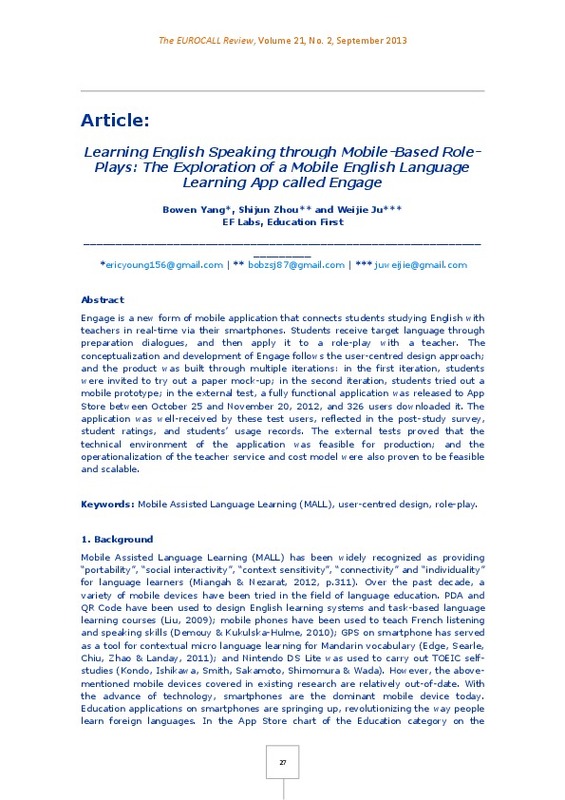JavaScript is disabled for your browser. Some features of this site may not work without it.
Buscar en RiuNet
Listar
Mi cuenta
Estadísticas
Ayuda RiuNet
Admin. UPV
Learning English Speaking through Mobile-Based Role-Plays: The Exploration of a Mobile English Language Learning App called Engage
Mostrar el registro sencillo del ítem
Ficheros en el ítem
| dc.contributor.author | Yang, Bowen
|
es_ES |
| dc.contributor.author | Zhou, Shijun
|
es_ES |
| dc.contributor.author | Ju, Weijie
|
es_ES |
| dc.date.accessioned | 2020-03-09T10:08:55Z | |
| dc.date.available | 2020-03-09T10:08:55Z | |
| dc.date.issued | 2013-09-29 | |
| dc.identifier.issn | 1695-2618 | |
| dc.identifier.uri | http://hdl.handle.net/10251/138525 | |
| dc.description.abstract | [EN] Engage is a new form of mobile application that connects students studying English with teachers in real-time via their smartphones. Students receive target language through preparation dialogues, and then apply it to a role-play with a teacher. The conceptualization and development of Engage follows the user-centred design approach; and the product was built through multiple iterations: in the first iteration, students were invited to try out a paper mock-up; in the second iteration, students tried out a mobile prototype; in the external test, a fully functional application was released to App Store between October 25 and November 20, 2012, and 326 users downloaded it. The application was well-received by these test users, reflected in the post-study survey, student ratings, and students’ usage records. The external tests proved that the technical environment of the application was feasible for production; and the operationalization of the teacher service and cost model were also proven to be feasible and scalable. | es_ES |
| dc.language | Inglés | es_ES |
| dc.publisher | Universitat Politècnica de València | es_ES |
| dc.relation.ispartof | The EuroCALL Review | es_ES |
| dc.rights | Reconocimiento - No comercial - Sin obra derivada (by-nc-nd) | es_ES |
| dc.subject | Mobile Assisted Language Learning (MALL) | es_ES |
| dc.subject | User-centred design | es_ES |
| dc.subject | Role-play | es_ES |
| dc.title | Learning English Speaking through Mobile-Based Role-Plays: The Exploration of a Mobile English Language Learning App called Engage | es_ES |
| dc.type | Artículo | es_ES |
| dc.identifier.doi | 10.4995/eurocall.2013.9788 | |
| dc.rights.accessRights | Abierto | es_ES |
| dc.description.bibliographicCitation | Yang, B.; Zhou, S.; Ju, W. (2013). Learning English Speaking through Mobile-Based Role-Plays: The Exploration of a Mobile English Language Learning App called Engage. The EuroCALL Review. 21(2):27-38. https://doi.org/10.4995/eurocall.2013.9788 | es_ES |
| dc.description.accrualMethod | OJS | es_ES |
| dc.relation.publisherversion | https://doi.org/10.4995/eurocall.2013.9788 | es_ES |
| dc.description.upvformatpinicio | 27 | es_ES |
| dc.description.upvformatpfin | 38 | es_ES |
| dc.type.version | info:eu-repo/semantics/publishedVersion | es_ES |
| dc.description.volume | 21 | es_ES |
| dc.description.issue | 2 | es_ES |
| dc.relation.pasarela | OJS\9788 | es_ES |
| dc.description.references | Burke, T. & Guest, A. (2010). Using role playing as a teaching strategy: an interdisciplinary approach to learning. Proceedings of the 2nd Annual Conference on Higher Education Pedagogy, 34-35. | es_ES |
| dc.description.references | Buzan, T. (1989). Use both sides of your brain. New York: Penguin. | es_ES |
| dc.description.references | Demouy, V. & Kukulska-Hulme, A. (2010). On the spot: using mobile devices for listening and speaking practice on a French language programme. Open Learning: The Journal of Open, Distance and e-Learning, 25(3), 217-232. https://doi.org/10.1080/02680513.2010.511955 | es_ES |
| dc.description.references | Edge, D., Searle, E., Chiu, K., Zhao, J. & Landay, J.A. (2011, May). Micromandarin: mobile language learning in context. 2011 Annual Conference on Human Factors in Computing Systems. Symposium conducted in Vancouver, BC, Canada. | es_ES |
| dc.description.references | Hyerle, D. (2004). Student successes with thinking maps: school-based research, results, and models for achievement using visual tools. CA: Corwin Press. ISO 13407 (1999). Human-centred design processes for interactive systems. London: British Standards Institution. | es_ES |
| dc.description.references | Karat, C. (1997). Cost-justifying usability engineering in the software life cycle. In M. Helander, T.K.Landauer and P.Prabhu (Eds.), Handbook of Human-Computer Interaction (pp. 653-688). Amsterdam: Elsevier. https://doi.org/10.1016/B978-044481862-1.50098-4 | es_ES |
| dc.description.references | Kondo, M., Ishikawa, Y., Smith,C., Sakamoto, K., Shimomura, H., and Wada,N. (2012). Mobile assisted language learning in university EFL courses in Japan: developing attitudes and skills for selfregulated learning. ReCALL, 24, 169187. https://doi.org/10.1017/S0958344012000055 | es_ES |
| dc.description.references | Kukulska-Hulme, A. and Shield, L.(2008). An overview of mobile assisted language learning: from content delivery to supported collaboration and interaction. ReCALL, 20(3), 271-289. https://doi.org/10.1017/S0958344008000335 | es_ES |
| dc.description.references | Kujala,S. (2003). User involvement: a review of the benefits and challenges. Behavior & Information Technology, 22(1),1-16. https://doi.org/10.1080/01449290301782 | es_ES |
| dc.description.references | Liu, T.-Y. (2009). A context-aware ubiquitous learning environment for language listening and speaking. Journal of Computer Assisted Learning, 25(6), 515-527. https://doi.org/10.1111/j.1365-2729.2009.00329.x | es_ES |
| dc.description.references | Miangah, T. M., and Nezarat, A. (2012). Mobile-assisted language learning. Journal of Distributed and Parallel Systems, 3(1), 309-319. https://doi.org/10.5121/ijdps.2012.3126 | es_ES |
| dc.description.references | Parrish, B. (2004). Teaching adult ESL: a practical introduction. New York: McGraw-Hill Companies. | es_ES |
| dc.description.references | Rubin, J. (1994). Handbook of usability testing: how to plan, design, and conduct effective tests. New York: Wiley. | es_ES |
| dc.description.references | Schafer, R. W. (1994). Scientific Bases of Human-Machine Communication by Voice. In D.B. Roe (Eds.), Voice communication between humans and machines(pp.34-75). Washington, D.C.: National Academy Press. | es_ES |
| dc.description.references | Senf, M. (2012, Dec). Role-play, simulations and drama activities. DocumBase. Retrieved from http://en.convdocs.org/docs/index-44311.html | es_ES |
| dc.description.references | Snyder, C. (2003). Paper prototyping: the fast and easy way to design and refine user interfaces. San Diego, CA: Morgan Kaufmann Pub. | es_ES |
| dc.description.references | Sousa, D. A. (2006). How the brain learns. CA: Corwin Press. | es_ES |
| dc.description.references | Traxler, J. (2007). Current state of mobile learning. International Review on Research in Open and Distance Learning, 8(2), 9-24. | es_ES |







![HTML file [HTML]](/themes/UPV/images/html.png)

